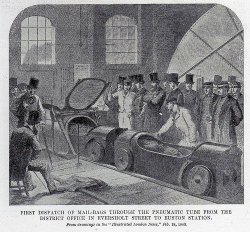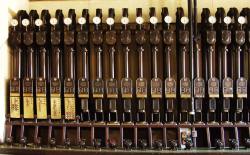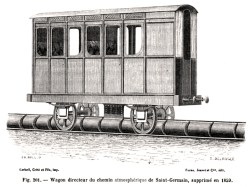Today, if you can find a pneumatic tube system at all, it is likely at a bank drive-through. A conversation in the Hackaday bunker revealed something a bit surprising. Apparently, in some parts of the United States, these have totally disappeared. In other areas, they are not as prevalent as they once were, but are still hanging in there. If you haven’t seen one, the idea is simple: you put things like money or documents into a capsule, put the capsule in a tube, and push a button. Compressed air shoots the capsule to the other end of the tube, where someone can reverse the process to send you something back.
These used to be a common sight in large offices and department stores that needed to send original documents around, and you still see them in some other odd places, like hospitals or pharmacy drive-throughs, where they may move drugs or lab samples, as well as documents. In Munich, for example, a hospital has a system with 200 stations and 1,300 capsules, also known as carriers. Another medical center in Rotterdam moves 400 carriers an hour through a 16-kilometer network of tubes. However, most systems are much smaller, but they still work on the same principle.
That Blows — Or Sucks?
Air pressure can push a carrier through a tube or suck it through the tube. Depending on the pressure, the carrier can accelerate or decelerate. Large systems like the 12-mile and 23-mile systems at Mayo Clinic, shown in the video below, have inbound pipes, an “exchanger” which is basically a switchboard, and outbound pipes. Computers control the system to move the carriers at about 19 miles per hour. You’ll see in the video that some systems use oval tubes to prevent the tubes from spinning inside the pipes, which is apparently a bad thing to do to blood samples.
In general, carriers going up will move via compressed air. Downward motion is usually via suction. If the carrier has to go in a horizontal direction, it could be either. An air diverter works with the blower to provide the correct pressures.
History
This seems a bit retro, but maybe like something from the 1950s. Turns out, it is much older than that. The basic system was the idea of William Murdoch in 1799. Crude pipelines carried telegram messages to nearby buildings. It is interesting, too, that Hero understood that air could move things as early as the first century.
In 1810, George Medhurst had plans for a pneumatic tube system. He posited that at 40 PSI — just a bit more than double normal sea-level air pressure — air would move at about 1,600 km/h. He felt that even propelling a load, it could attain a speed of 160 km/h. He died in 1827, though, with no actual model built.
In 1853, Josiah Latimer Clark installed a 200-meter system between the London Stock Exchange and the telegraph office. The telegraph operator would sell stock price data to subscribers — another thing that you’d think was more modern but isn’t.
Within a few years, the arrangement was common around other stock exchanges. By 1870, improvements enabled faster operation and the simultaneous transit of multiple carriers. London alone had 34 kilometers of tube by 1880. In Aberdeen, a tube system even carried fish from the market to the post office.
There were improvements, of course. Some systems used rings that could dial in a destination address, mechanically selecting a path through the exchange, which you can see one in the Mayo Clinic video. But even today, the systems work essentially the way they did in the 1800s.
Famous Systems
Several cities had pneumatic mail service. Paris ran a 467 km system until 1984. Prague’s 60 km network was in operation until 2002. Berlin’s system covered 400 km in 1940. The US had its share, too. NASA’s mission control center used tubes to send printouts from the lower floors up to the mission control room floor. The CIA Headquarters had a system running until 1989.
In 1920 Berlin, you could use the system as the equivalent of text messaging if you saw someone who caught your eye at one local bar. You could even send them a token of your affection, all via tube.

In 1812, there was some consideration of moving people using this kind of system, and there were short-lived attempts in Ireland, London, and Paris, among other places, in the mid-1800s. In general, this is known as an “atmospheric railroad.”
As a stunt, in 1865, the London Pneumatic Despatch Company sent the Duke of Buckingham and some others on a five-minute trip through a pneumatic tube. The system was made to carry parcels at 60 km/h using a 6.4-meter fan run by a steam engine. The capsules, in this case, looked somewhat like an automobile. There are no reports of how the Duke and his companions enjoyed the trip.

A 550-meter demonstration pneumatic train showed up at the Crystal Palace in 1864. Designed by Thomas Webster Rammell. It only operated for two months. A 6.7-meter fan blew air one way for the outbound trip and sucked it back for the return.
Don’t think the United States wasn’t in on all this, too. New York may be famous for its subway system, but its early predecessor was, in fact, pneumatic, as you can see in the video below.

Many of these atmospheric trains didn’t put the passengers in the capsule, but used the capsule to move a railcar. The Paris St. Germain system, which opened in 1837, used this idea.
Modern Times
Of course, where you once would send documents via tube, you’d now send a PDF file. Today, you mainly see tubes where it is important for an actual item to arrive quickly somewhere: an original document, cash, or medical samples. ThyssenKrupp uses a tube system to send toasty 900 °C steel samples from a furnace to a laboratory. Can’t do that over Ethernet.
There have been attempts to send food over tubes and even take away garbage. Some factories use them to move materials, too. So pneumatic tubes aren’t going away, even if they aren’t as common as they once were. In fact, we hear they are even more popular than ever in hospitals, so these aren’t just old systems still in use.
We haven’t seen many DIY pneumatic tube systems that were serious (we won’t count sucking Skittles through a tube with a shop vac). But we do see it in some robot projects. What would you do with a system like this? Even more importantly, are these still common in your area or a rarity? Let us know in the comments.
















I was involved in the restoration of the pneumatic tube system on the historic NS Savannah nuclear merchant ship, which is currently docked in Baltimore. The system was used to send messages to be transmitted ship-to-shore to the radio room from the purser’s desk. The system hadn’t operate for decades but was surprisingly easy to get working again. A new rubber belt and some cleaning was all that was needed. The original capsules also cleaned up well.
You forgot to include the video: https://youtu.be/auUEqhPMGHk
Yeah, I was too lazy to look it up. Thanks for posting it.
Famous, not mentioned: https://en.wikipedia.org/wiki/Pneumatic_tube_mail_in_New_York_City
Not famous, not mentioned, but cool: The Rabbit Line, fires radioisotopes from the TRIUMF particle accelerator 2.5 km to the point of use: https://ingeniumcanada.org/channel/innovation/down-rabbit-line-transporting-medical-isotopes and featured by Tom Scott https://www.youtube.com/watch?v=eMTZvA8iFgI
In recent years the EU has actually regessed on that front. Instead of robots taking out and sorting our trash, we have to do it ourselves.
All plastic bottles now have deposit fee on them. You are NOT allowed to dump them into “plastics” bin anymore. They must be taken back to the store and fed to the so-called “reverse vending machine”: https://en.wikipedia.org/wiki/Reverse_vending_machine
Because “plastics” bins now have less plastic in them, local companies operating trash disposal earn less money from renewable resources and in turn had to increase rates we pay for trash collection.
tl;dr
Soda costs more because of “eco” deposit on plastic bottle.
We have to bring empty bottle back to the store and hope vending machine isn’t “temporarily out of order”.
We pay more for trash disposal because we produce less plastic.
🤡 Clown world at it’s finest 🤡
Yeah, “fancy and clean” stations would require a culture that valued those things and probably homogenous. See the subways systems of South Korea, Japan, Russia, China.
Funny enough I was at a new hospital in Austria today, and I was pleasantly surprised to see a nice modern system sending blood samples and other stuff all around the hospital. I was even graced with watching the end point plop out and suck in some canisters, so the tech is alive and well.
The banks in my area got rid of the tubes at drive throughs years ago. Now, the lane closest to the building has a slide out drawer and the other lane(s) have ATMs
The Safe House in Milwaukee features a pneumatic tube system to deliver its signature “Spytini” from the bar to guests. The drink is shaken, not stirred, then sent through the tube, which travels 600 feet around the restaurant before being poured into a chilled glass for the customer. This is one of many unique, spy-themed features at the restaurant, which include secret passages and other gadgets shown in this YouTube video.
https://youtu.be/bo1hjpb2fMo
It’s really one of my favorite places in all of the Midwest, along with American Science & Surplus.
What your saying is: ‘Never go to Milwaukee.’
Good advice.
Better advice: ‘Never go to Wisconsin.’
They boil hamburgers there and think it’s a thing to brag about.
Celebrate their Scandinavian roots w rotten fish and buckets of alcohol.
I hear the internet is a bunch of tubes too.
Hmmm….thinking station wagon (tube capsule) full of magtapes (SD cards) here, and wondering what the throughput of a typical pneumatic tube system might be…
about pneumatic tubes :D
https://www.themarysue.com/vacuum-thieves-paris/